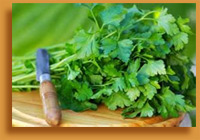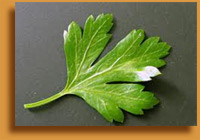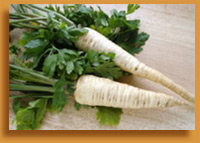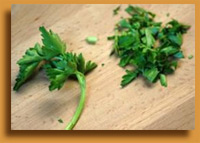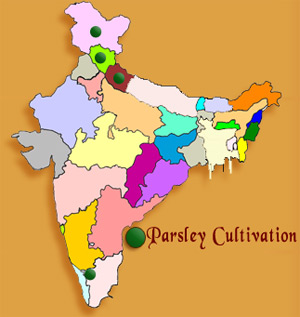PARSLEY
Introduction
The appetizing and lively taste and magnificent healing properties of parsley are often unnoticed because of its popular job as a table garnish. Exceedingly nutritious, parsley can be found in your neighboring supermarket. Parsley is the world's most accepted herbs. It gets its name from the Greek word denoting "rock celery". It is a vertical, biennial plant with a plump sweet-smelling tap root and dark shimmering leaves which climb from a little stem. It is the dried out sweet-smelling leaves of a biennial herb with dense leaves and white flowers. The dazzling green leaves are finely separated and coiled. There are two major types of horticultural parsleys.
The one cultivated for the leaves, which is found in India and the other grown for its turnip like roots. The flowering stalk reaches up to an altitude of 100 cm in the second year. Flowers are yellow or yellowish green in mix umbels. Fruits 2-3 mm long, semi-circular in shape, noticeably rigid and consists of two mericarps. Leaves and seeds are the parts that are used as a spice. The smell of the herb is very characteristic, sweet-smelling and spicy due to its volatile oil presence.
Common Names
Petroselinum crispum is the biological name of parsley. In the in Indian common languages ie., in Hindi it is called as Ajmood, in Kannada it is called as Achu-Mooda, in Malayalam it is called as Seema malli.
History
Parsley is inhabited to the Mediterranean region of Southern Europe. While it has been grown for more than 2,000 years, parsley was used medicinally aforementioned to being consumed as a food. The ancient Greeks believed parsley to be sacred, using it to not only to decorate victors of sporty contests, but also for decorating the tombs of the dead. The practice of using parsley as a embellishment in fact has a lengthy history that can be traced back to the society of the ancient Romans. While it is unsure when parsley began to be frenzied as a seasoning, it seems to be sometime in the central Ages in Europe.
A few historians pay tribute to Charlemagne with its popularization since he had it cultivated in his lands. In some countries, the coiled leaf variety is more accepted. This may have its roots in the ancient liking for this type since people were often reserved to eat the smooth leaf variety because it resembled fool's parsley, a toxic weed. Turnip-rooted or also called as Hamburg parsley, is a comparatively new species, having only been urbanized within the past two hundred years but only lately it begun gaining recognition.
Types of parsleys
Leaf Parsley
The two major groups of parsley used as herbs are curly leaf or flat leaf. Of these, the neapolitanum group further strongly resembles the natural untamed species. Flat-leaved parsley is favored by some as it is easier to cultivate, being more forbearing of both rain and sunshine, and has a stronger savor though this is disputed, while the curly leaf parsley is favored by others because of its more ornamental appearance in garnishing. A third type, at times grown in southern Italy, has bulky, celery-like leaf stems.
Root Parsley
Another type of parsley cultivated as a root vegetable is called the Hamburg root parsley. This type of parsley gives much thicker roots than types grown for their leaves. Even though hardly ever used in Britain and the United States, root parsley is extremely widespread in central and eastern European Cuisine, where it is used in soups and stews. Though root parsley looks comparable to the parsnip, it tastes somewhat different. Parsnips are amongst the contiguous relatives of parsley in the family Apiaceae, but the resemblance of the names is a twist of fate, parsnip denoting "forked turnip"; it is not intimately connected to the real turnips
Uses
Cooking
No kitchen ought to be with no good furnish of this multi-purpose herb. It can be used as a garnish and flavoring agent and as a vegetable that can be cooked as a dish. Parsley can be used in almost all of the savory dishes. It is particularly good to be used in grand quantities in fresh salads or in soups and tomato sauces. It is chopped and mixed with butter and is let to melt over fish or vegetables. There's just as a good deal of flavor in the stalk as in the leaf and both are used to flavor stews and stocks. It is very delicious when momentarily deep-fried and served as a vegetable. It is used in marinades, stuffings, in omelettes, etc. Fresh parsley is ought to be washed right before use since it is highly delicate The most excellent way to clean it is just like you would clean spinach.
As it has a stronger flavor than the coiled variety, Italian smooth leaf parsley holds up superior to cooking and therefore is frequently the type chosen for hot dishes. It should be added towards the end of the cooking course so that it can best keep hold of its taste, color and nutritional value.
Medicine
A branch of parsley can offer much more than a beautification on your plate. Parsley consists of two types of odd elements that provide exceptional health benefits. The first type is unpredictable oil components that include myristicin, limonene, eugenol, and alpha-thujene. The second type is flavonoids that include apiin, apigenin, crisoeriol, and luteolin. Parsley's unpredictable oils particularly myristicin have been revealed to restrain tumor development in animal studies, and chiefly, tumor development in the lungs.
Myristicin has also been revealed to activate the enzyme known as glutathione-S-transferase, which helps to attach the fragment glutathione to oxidized molecules that would or else do damage in the body.
Parsley Cultivation in India
